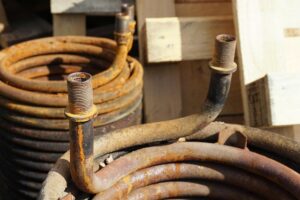Industrial air doors provide robust solutions for harsh environment entry points, sealing out weather conditions, dust, and pollutants. They enhance safety, operational efficiency, and energy effectiveness in manufacturing, warehousing, and loading docks, outperforming standard doors that often fail due to extreme temperatures, humidity, and chemicals. Corrosion-resistant materials and advanced sealing systems ensure longevity and reliability, making them ideal for climate separation in challenging conditions like marine, manufacturing, and cold storage industries. Strategic selection based on door size, usage frequency, and climate separation needs is crucial for optimal performance.
In many industries, maintaining controlled environments is paramount, especially in harsh settings where standard doors struggle. This is where industrial air doors step in as robust solutions. This article explores the critical role of these doors in mitigating corrosive environments, detailing their benefits and unique features. We’ll delve into common challenges faced by traditional doors, guide you through selecting the right corrosion-resistant systems, and provide implementation strategies for optimal performance. Discover how industrial air doors ensure longevity and efficiency even in the toughest conditions.
- Understanding Industrial Air Doors: Their Role and Benefits in Harsh Environments
- Common Challenges Facing Standard Doors in Aggressive Settings
- Key Features and Materials for Corrosion-Resistant Industrial Air Doors
- Implementation Strategies: Selecting and Installing the Right Corrosive Environment Door System
Understanding Industrial Air Doors: Their Role and Benefits in Harsh Environments

Industrial air doors play a pivotal role in creating robust and efficient entry points for harsh environments, offering significant advantages where traditional doors falter. These specialized door systems are designed to withstand extreme conditions, ensuring secure and controlled access in various industries. By employing powerful air pressure, they create an airtight seal, preventing unwanted elements such as weather conditions, dust, or pollutants from penetrating the building, which is crucial for maintaining indoor environments in manufacturing facilities, warehouses, and cold storage units.
Beyond providing climate separation, industrial air doors act as versatile entrance barriers, enhancing safety and operational efficiency. They are ideal solutions for factory entrances, loading docks, and large openings where quick entry and exit are necessary. Their heavy-duty construction guarantees durability, making them reliable assets for various manufacturing door systems. These doors also contribute to improved energy efficiency by acting as industrial HVAC barriers, controlling the flow of air and minimizing temperature fluctuations.
Common Challenges Facing Standard Doors in Aggressive Settings

Standard doors often face significant challenges when deployed in aggressive settings. These harsh environments, characterized by extreme temperatures, high humidity levels, and corrosive substances, can accelerate door wear and tear, compromising their lifespan and performance. For instance, in manufacturing plants, warehousing, or cold storage facilities, where industrial processes generate significant heat, moisture, and potentially corrosive chemicals, standard doors may struggle to maintain integrity, leading to frequent replacements and downtime for maintenance.
Moreover, loading docks, factories, and other industrial areas require effective climate separation and robust entrance solutions like heavy-duty air doors (also known as large opening air curtains) or industrial HVAC barriers. These door systems must withstand constant use, intense weather conditions, and the presence of heavy vehicles, ensuring seamless operations while safeguarding interior spaces from external elements. The need for durable and corrosion-resistant materials is paramount to prevent premature failure, thereby offering a cost-effective and reliable solution for maintaining optimal working conditions in these demanding environments.
Key Features and Materials for Corrosion-Resistant Industrial Air Doors

Corrosion-resistant industrial air doors are designed to withstand the toughest conditions, making them essential for harsh environments. Key features include robust construction with high-quality materials like stainless steel and aluminum alloys, which offer superior durability against rust and corrosion. These materials ensure the doors can handle extreme temperatures, moisture, and chemical exposure, vital factors in industries such as manufacturing, warehousing, and cold storage.
Advanced sealing technologies, such as multi-point sealing systems, further enhance their resistance to air leaks and water intrusion. Additionally, the use of non-toxic, fire-retardant coatings improves safety while maintaining the doors’ structural integrity. These features make corrosion-resistant industrial air doors ideal for various applications, including loading dock barriers, warehouse opening protection, factory entrance solutions, and industrial climate separation, providing efficient HVAC (Heating, Ventilation, and Air Conditioning) control while ensuring a robust barrier against external elements.
Implementation Strategies: Selecting and Installing the Right Corrosive Environment Door System

When selecting and installing industrial air doors for harsh environments, it’s crucial to consider specific implementation strategies tailored to the unique challenges of each application. The right door system should be designed to withstand not only extreme weather conditions but also exposure to corrosive elements like salt, moisture, and chemicals prevalent in industries such as marine, manufacturing, and cold storage.
Choosing between heavy-duty air doors, warehouse opening protection mechanisms, or factory entrance solutions involves evaluating factors like door size, expected usage frequency, and required climate separation. For instance, large opening air curtains are ideal for vast warehouse spaces, while cold storage air doors are specifically engineered to maintain temperature control in refrigerated environments. Effective industrial HVAC barriers further ensure optimal indoor conditions by controlling airflow and preventing external contaminants from entering production areas.
Industrial air doors are essential components in harsh environments, offering a robust solution for maintaining controlled spaces. By understanding the unique challenges faced by standard doors and leveraging key features like corrosion-resistant materials, businesses can select the right door system to withstand aggressive settings. Implementation strategies highlighted in this article provide a roadmap for successful installation, ensuring optimal performance and longevity of these game-changing industrial air doors.






